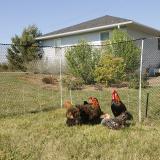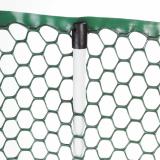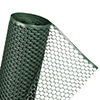NoShock™ Chick Fence
To contain chicks and ducklings when they are too small to be contained by PoultryNet. Also used to keep free-range flocks out of flower beds, gardens, patios, roadways, etc. Non-electrifiable.
Semi-Permanent—How to use…
Same setup as the
temporary fence, but place
18" RaccoonNet around the outside of it.
42" PoultryNet or
48" PoultryNet will work too. The addition of an electrified fence protects birds from predators.
Specifications:
- Supplied in 50 ft rolls
- Height: 48" (4 ft) tall
- Choice of either black or green
- Plastic mesh
- 3/4" openings
About Conductivity
Conductivity measures the amount of electrical current a material can carry. The opposite measure is known as resistance.

Many of Premier’s electric net fences feature a green and white superconductor that has both stainless steel and tinned copper filaments for optimal conductivity.
These “premium” nets are 10 times more conductive (38 ohms per 1000') than “basic” nets offered by our competitors. This enables the electric pulse to travel much farther and be less affected by weed contact.
Customers who are unhappy with netting are often those who’ve chosen nets from China or their farmstore equivalents.
Types of Line Posts
Line posts are built into the net. Three options are available.*
![Line Posts Compared]()
- Single Spike (SS)
The best choice, unless your soils are always soft or very hard.
- Double Spike (DS)
Posts allow you to push in the spikes with your foot. When soil is hard or rocky, double spikes are more difficult to install and remove.
- Drivable Posts (DP)
Allows use of a mallet or dead blow hammer for installing posts in dry, hard or rocky soil. Features a “spike stop” for extra support and internal fiberglass ribs for added strength.
Tip: To insert a line post into frozen or hard soil, use a power tool to drill pilot holes.
* Not all fences have all line post options.
About Positive/Negative (Pos/Neg) Nets
Is your area dry?
Conventional electrified fence systems rely on soil moisture to be effective. However, not all areas have the required moisture.
Dry soil increases resistance—a weaker, less effective pulse occurs that does not deter animals.
To overcome this, Pos/Neg nets* are wired to allow the use of every other horizontal strand as an extension of the ground terminal. Because half the strands are connected to the ground terminal or ground rod, reliance on soil moisture is reduced. A PowerLink must be purchased separately to make the secondary ground connection.
How it works…
In order to receive a shock, the animal must touch both a positive (hot) and negative (grounded) strand at the same time. This will deliver more pain to the animal than an all hot net (Pos/Pos) because moisture in the soil is not required to complete the circuit.
Pos/Neg fences can be converted to Pos/Pos in moist conditions. Remember, all fences must be kept free of vegetation.
* Not all fences have Pos/Neg options.
Line Post Spacing
“Plus” nets—6'8" spacings between built-in line posts*
![Line Post Spacing]()
Standard nets—10' or 12' spacings between built-in line posts*
* Spacings are approximate.
Distance between built-in line posts may vary by product.
Essential Energizer Advice
- Buy a larger energizer than necessary. When the fence pleases, most folks will buy more fence—and need additional output.
- Use a low-impedance intermittent pulse energizer.
- Use a fence tester to check the voltage often.
- Use enough ground rod(s)—included with our energizer kits.
- Don’t allow your lead acid battery to discharge below 40%.
- Use insulated wire that is designed for electric fences.
- Always connect the fence to an energizer, not an outlet.
- Visit this link for answers to other common energizer questions.
Two Basic Types
- All-in-one Solar
- Solar units are very portable.
- Because they need a battery, these units are more costly to purchase and operate than plug-in units.
- Batteries are less effective in cold temperatures (deplete faster).
- Most farmstore solar units are too weak, in joules of output, to properly energize netting. That’s why we designed our own.
- Plug-in & Battery
- Least cost to purchase and operate per joule of output.
- Best for fences exposed to heavy vegetation.
- Cold temperatures do not affect performance.
- Recommended for whole-farm systems, but can be complex to install. Higher output requires more ground rods, underground cables, multiple output terminals, etc.
Braided vs. Twisted
Braiding instead of twisting the horizontals increases the frequency of metal filaments on the outside of the strand.
![Braided vs. Twisted Electric Net Fences]()
What’s the benefit?
- More metal is exposed on the outside of the strand. This enables improved animal to conductor contact. The electric pulse is better able to travel from the fence and into the animal, resulting in a memorable shock.
- A tighter, braided weave results in fewer snags when carried or pulled through pastures, reducing frustration.
We offer many fences to fit your situation, including different heights and lengths, multiple colors, drivable posts and positive/negative options for dry soils. Questions? Call our fence consultants at 800-282-6631 for expert advice.













